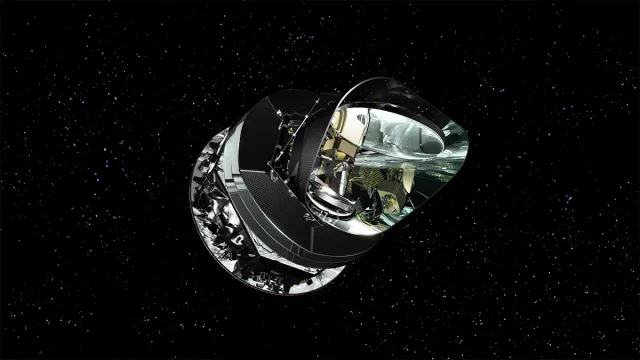From 2009 to 2013, the European Planck satellite surveyed the celestial sphere to analyse the cosmic microwave background, the ‘first light’ from just 380,000 years after the Big Bang, amassing precious data to tell us more about the birth of the universe and how its large-scale structures formed.
Key information
| Mission | Study the cosmic microwave background (CMB) |
|---|---|
| Domain | Science |
| Launch date | 14 May 2009 |
| Partners | ESA |
| Where | In orbit around the L2 Lagrange point (1.5 million km from Earth) |
| Lifetime | 4½ years (ended 23 October 2013) |
| Status | Completed |
Key figures
- 1,921 kg: satellite mass
- 1.5-m-diametre mirror
- 30 to 857 GHz: range of observable frequencies
- 2 instruments
Key milestones
- 23 October 2013: End of mission
- 3 July 2009: Planck goes into orbit at L2 Lagrange point
- 14 May 2009: Planck launched by Ariane 5 ECA
- 26 March 2006: Start of cryogenic testing of flight model of the satellite, renamed Planck
- 1996: ESA selects COBRAS/SAMBA for its Horizon 2000 programme
- May 1993: COBRAS/SAMBA project kicks off
Project in brief
According to the Big Bang model, there was a lot of light in the primordial universe. While this light has been greatly diluted as the universe expanded, it can still be detected by surveying the skies. The remnants of this first light, called the cosmic microwave background (CMB), were analysed from May 2009 to October 2013 by the Planck satellite, allowing astrophysicists to take a ‘snapshot’ of the universe as it was just 380,000 years after the Big Bang and learn more about its birth and the formation of galaxies.
To observe this fossil radiation, Planck used its 1.5-metre-diameter telescope and two instruments: LFI (Low Frequency Instrument) and HFI (High Frequency Instrument), the latter operating in the submillimetre range of the spectrum where very cold objects emit.
CNES’s role
Planck was an astronomy mission of ESA’s mandatory scientific programme. CNES was involved through its contribution to this programme and through its participation in developing the HFI instrument, led by French science teams, and its data processing centre.
Contacts
Astronomy & Astrophysics subject matter expert
Philippe Laudet
E-mail: philippe.laudet at cnes.fr


